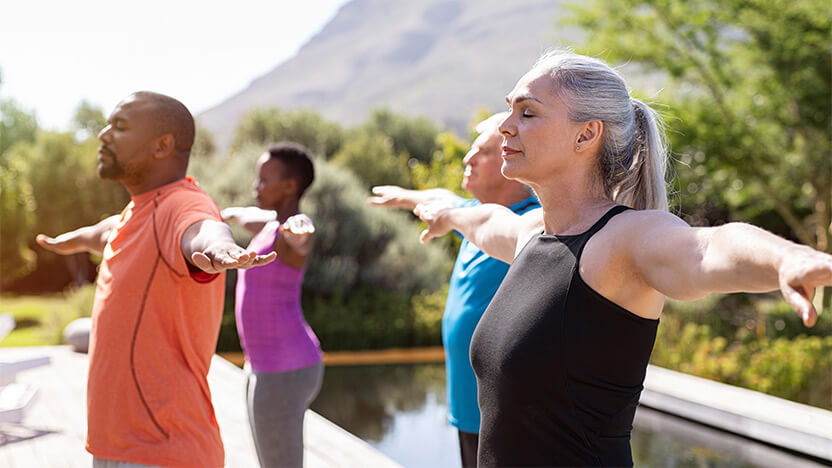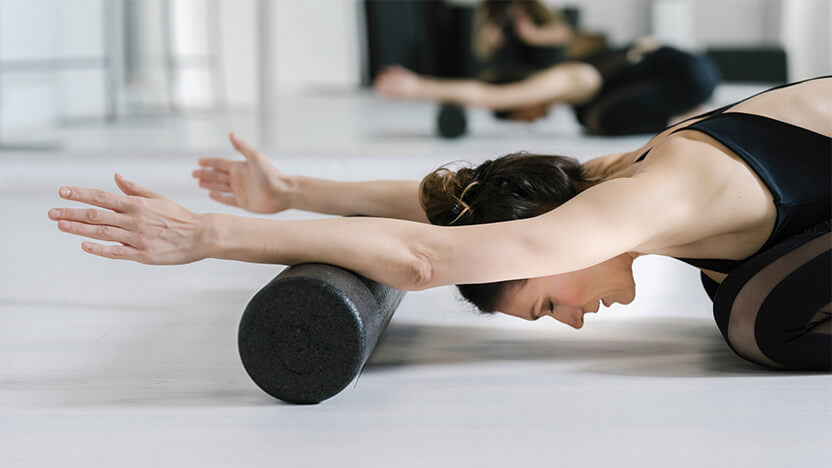
Breath has always been the first principle taught to students and clients learning and practicing the STOTT PILATES® Movement System.
Efficient breathing, or lack thereof, can have a profound impact on the performance of an individual exercise and on the activities of daily life.
Understanding the power of the breath can help you get into the right frame of mind for whatever activity you’re doing. You can develop the efficiency, power and mental fortitude to be successful. But it’s also important to understand that the optimal way to breathe may depend on the desired outcome.
As we continue to explore the STOTT PILATES Principle of breathing in the third installment in this series, we must first discuss the three-dimensional nature of breath. As we’ve mentioned before, the motions of the rib cage during respiration can be described as a ‘pump handle,’ ‘bucket handle’ and ‘caliper.’
Understanding rib cage biomechanics in three-dimensional breathing
Pump handle: This action relates to vertical breathing, where the expansion is mostly in the upper part of the lungs, causing the rib cage to lift superiorly both in the front and the back, then release down again.
When vertical breathing occurs, the accessory muscles of the upper neck and shoulders, particularly the sternocleidomastoid and scalenes, are used. The breath rate is usually faster and shallower, so the gas exchange is much less effective.
Bucket handle: With this emphasis, the rib cage expands laterally and elevates slightly, then reverses direction.
Caliper: This motion is reserved for the lowest two or floating ribs. Their motion is almost completely in a sideways direction. The last two can be collectively called lateral breathing. This type of breath allows the oxygen to travel deeper into the lungs and create a more efficient gas exchange.

The diaphragm’s role in efficient breathing
In every type of inhalation, the diaphragm plays a crucial role. As the diaphragm contracts and depresses, negative pressure is developed in the thoracic cavity, and air is drawn in.
When the diaphragm relaxes, it ascends into the thoracic cavity and the air is pressed out. As the diaphragm lowers, the abdominal viscera are compressed, causing the abdomen to expand slightly.
In order to be efficient with the breath, there must be space for that expansion. If the abdominal muscles are held in a contracted position, the diaphragm will not be able to descend as far, and may cause only vertical breath to occur. This does not mean that the abdominal muscles are allowed to completely relax, but there must be some expansion available.
Feeling the abdominal expansion with a deep breath is a great way to notice the decent of the diaphragm into the abdominal cavity.
Practicing a more efficient breath pattern will help strengthen the diaphragm. This in turn will help the other deep stabilizing muscles, namely the pelvic floor, transversus abdominis and multifidus, to perform optimally.
Just like you would strengthen your leg muscles to be able to jump higher, it is important to strengthen the diaphragm and ensure it is working in synchronicity with these muscles to become more effective and efficient. It can also help control posture in order to avoid injuries and prevent back pain.
Three tips for developing more efficient breathing habits
- Create sensory awareness of your natural breath pattern while performing your regular daily tasks
- Learn and educate yourself on efficient ways to breathe; we’ve got more resources here and here
- Practice efficient breath patterns; your Pilates class is a great place to start

Try nasal breathing: This inhale through the nose, exhale through the nose breathing pattern can be used as a technique to make the diaphragm work harder to draw the air into the thoracic cavity.
This allows you to control the volume and speed of the breath, so more oxygen is drawn into the lungs on the inhale, and the optimal amount of CO2 is released during the exhale. If not enough C02 is released, the body becomes over-oxygenated, which causes the breath to become shallower. This is where the benefits of controlled breathing become more apparent.
Effective breathing techniques for Pilates
Employing effective breathing techniques for Pilates exercises can improve overall performance and decrease negative tension.
When introducing a new breath pattern, choose the breathing technique that is most effective for the client and the task at hand.
If nasal breathing doesn’t work, then use the more traditional inhale through the nose and exhale through the mouth pattern.
Breathing should not be part of choreography. The importance of breathing well is more in understanding the breath, so we can give clients the ammunition to breathe more effectively in any situation.
The breath pattern should create greater efficiency and not be something that makes the client confused or the movement more complicated. As mentioned in our last post, it is often most effective to teach the movement pattern first, then layer on the breath, choosing whatever breathing technique works best for the client.
The art and science of breathing is ever-evolving, and as more research is done, our application of breathing techniques will also change.
Exploring different breathing techniques and styles is exciting and provides Pilates, fitness and mind-body instructors with more tools to ensure their clients are getting the most out of every exercise.
Read the other articles in this series:
Breathing Techniques: What Is a Natural Breath Pattern and How Can I Breathe More Efficiently?
Breathing Techniques: How to Adapt STOTT PILATES® Breathing to Make Pilates Exercises More Effective